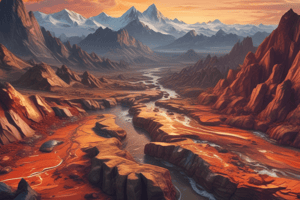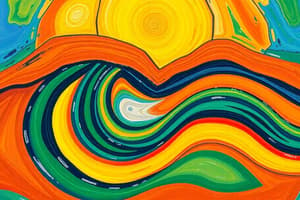Podcast
Questions and Answers
What distinguishes P (Primary) Waves from S (Secondary) Waves?
What distinguishes P (Primary) Waves from S (Secondary) Waves?
- P Waves are slower than S Waves, which are faster and cause more energy release.
- P Waves move the ground side-to-side, while S Waves push and pull the ground in the direction of travel.
- P Waves are compressional, moving the ground in the direction of travel, while S Waves are shear waves moving perpendicular to that direction. (correct)
- P Waves only travel through the Earth's crust, while S Waves penetrate the entire Earth.
Which statement about Surface Waves is true?
Which statement about Surface Waves is true?
- Surface Waves cause more damage than Body Waves and travel along the Earth's surface. (correct)
- Surface Waves are only composed of Rayleigh Waves.
- Surface Waves are only generated by earthquakes occurring deep beneath the Earth.
- Surface Waves travel faster than Body Waves and cause minimal ground movement.
What is the main difference between magnitude and intensity in the context of measuring earthquakes?
What is the main difference between magnitude and intensity in the context of measuring earthquakes?
- Magnitude measures the energy released at the source, while intensity measures the effects felt at specific locations. (correct)
- Magnitude is a qualitative measure, while intensity is quantitative.
- Magnitude measures local shaking, while intensity measures the energy released.
- Magnitude is only relevant for large earthquakes, while intensity applies to all magnitudes.
What motion characterizes Rayleigh Waves during an earthquake?
What motion characterizes Rayleigh Waves during an earthquake?
Which type of wave causes horizontal shearing of the ground?
Which type of wave causes horizontal shearing of the ground?
What primarily causes tectonic earthquakes?
What primarily causes tectonic earthquakes?
Which type of earthquake is associated with volcanic activity?
Which type of earthquake is associated with volcanic activity?
What percentage of all earthquakes are classified as tectonic earthquakes?
What percentage of all earthquakes are classified as tectonic earthquakes?
What is the main difference between an earthquake and a tremor?
What is the main difference between an earthquake and a tremor?
What drives the movement of tectonic plates?
What drives the movement of tectonic plates?
Which of the following best describes induced seismicity?
Which of the following best describes induced seismicity?
What defines stress in geological terms?
What defines stress in geological terms?
Where do tectonic plates meet and interact?
Where do tectonic plates meet and interact?
What type of stress occurs when forces pull apart?
What type of stress occurs when forces pull apart?
Which type of fault is formed when rocks on the uphill side of an inclined plane rise above the other side?
Which type of fault is formed when rocks on the uphill side of an inclined plane rise above the other side?
What is the focus of an earthquake?
What is the focus of an earthquake?
Which seismic wave causes the ground to shake as it travels through the Earth due to a sudden energy release?
Which seismic wave causes the ground to shake as it travels through the Earth due to a sudden energy release?
What is the type of fault where blocks of rock move past each other along a nearly vertical fracture?
What is the type of fault where blocks of rock move past each other along a nearly vertical fracture?
At which type of plate boundary are normal faults most commonly found?
At which type of plate boundary are normal faults most commonly found?
What does strain refer to in the context of stress applied to rocks?
What does strain refer to in the context of stress applied to rocks?
What happens during the elastic rebound theory of earthquakes?
What happens during the elastic rebound theory of earthquakes?
Flashcards are hidden until you start studying
Study Notes
Types of Earthquakes
- Tectonic earthquakes are caused by the sudden release of energy in the Earth's crust due to the movement of tectonic plates.
- Volcanic earthquakes are associated with volcanic activity and are caused by vibrations generated by the movement of magma or other fluids within the volcano.
- Man-made earthquakes are also known as induced seismicity. These earthquakes can occur due to human activities such as fluid extraction and mining.
The Difference Between an Earthquake and Tremor
- Tremors are generally regarded as milder seismic vibrations than earthquakes.
- The magnitude of the event differentiates an earthquake from a tremor.
### Tectonic Plate Movement and Earth’s Layers
- Tectonic plates are large, rigid pieces of the Earth's lithosphere, which consists of the upper mantle and crust.
- These plates move slowly over the semi-fluid asthenosphere, which is beneath them.
- The movement of the plates is driven by forces such as convection currents in the Earth's mantle, gravity, and the Earth's rotation.
### Stress and Strain
- Stress is the force applied per unit area on a material.
- Strain is the deformation that results from the applied stress.
### Types of Stress
- There are three kinds of stress that act on Earth’s rocks:
- Tensive stress occurs when forces pull apart.
- Compressive stress occurs when forces push together.
- Shear stress occurs when forces slide past each other.
Elastic Rebound Theory
- The gradual accumulation and release of stress and strain is referred to as the "elastic rebound theory" of earthquakes.
- Most earthquakes are the result of the sudden elastic rebound of previously stored energy.
Faults
- A fault is a fracture or zone of fractures in the Earth's crust along which there has been movement of the rock.
- The area directly above where two tectonic plates interact is known as the fault.
Types of Faults
- Normal Fault: The most common type, it forms when rock above an inclined fracture plane moves downward, sliding along the rock on the other side of the fracture. Normal faults are often found along divergent plate boundaries.
- Reverse Fault: The opposite of a normal fault. A reverse fault forms when the rocks on the “uphill” side of an inclined fault plane rise above the rocks on the other side. Reverse faults often form along convergent plate boundaries.
- Strike-Slip Fault: This type forms when the blocks of rock on either side of a vertical (or nearly vertical) fracture move past each other.
The San Andreas Fault
- The San Andreas Fault is a strike-slip fault that marks the boundary between the Pacific Plate and the North American Plate.
Focus and Epicenter
- The focus is the point inside the Earth where an earthquake originates. It releases energy during an earthquake.
- The epicenter is the point on the Earth's surface directly above the origin of an earthquake. It indicates the point of maximum damage on the Earth's surface.
### Seismic Waves
- Seismic waves are the waves of energy that travel through the Earth as a result of a sudden release of energy in the Earth's crust.
- These waves cause the ground to shake and are the reason we feel earthquakes.
Types of Seismic Waves
- Body Waves: These waves travel through the interior of the Earth and are the first waves to be detected by seismographs during an earthquake.
- P (Primary) Waves: These waves are compressional waves that push and pull the ground in the direction the wave is traveling.
- S (Secondary) Waves: These waves are shear waves that move the ground side-to-side, perpendicular to the direction of wave travel.
- Surface Waves: These waves travel along the Earth's surface and cause the most damage during an earthquake.
- Love Waves: These waves only move through the Earth's crust and cause horizontal shearing of the ground.
- Rayleigh Waves: These waves cause the ground to move in an elliptical, rolling motion, with both vertical and horizontal displacement.
Earthquake Measurement
- Magnitude: This measures the energy released at the source of the earthquake. It is typically measured using seismographs.
- Intensity: This measures the effects of an earthquake at specific locations and assesses how much shaking is felt and the resulting damage. It is a qualitative measure and can vary significantly from place to place.
Studying That Suits You
Use AI to generate personalized quizzes and flashcards to suit your learning preferences.




